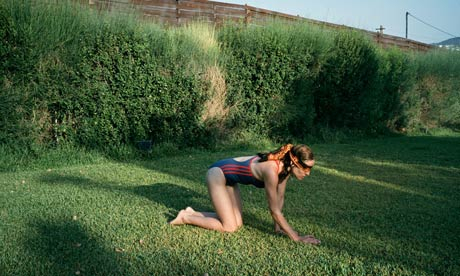This is a guest post by Janie Contreras-Johnson.
On a micro level, Yorgos Lanthimos’s film, Dogtooth, is a portrayal of one family’s socialization, yet on a macro level, it challenges its audience to reflect on the ways in which society accepts and perpetuates social norms. By introducing the audience to a tight-knit family with a very peculiar upbringing, the film allows a glimpse into socialization, explores gender politics, and shows how art can lead to individualism.
The film is set in a non-descript location that—only by the language spoken—the audience knows is Greece. The film revolves around a family wherein the parents employ bizarre methods to keep their three adult children safe and obedient under their roof.
Lanthimos immediately introduces the audience to the unusual development of this family; the first scene finds the three adult children listening to a taped recording of their mother giving a vocabulary lesson. We hear common words, but the definitions the tape is providing are inaccurate (“Highway: a gently blowing breeze”). It is one of the many times in the film Lanthimos establishes the childlike innocence and obedience that puts the children at the mercy of those meant to care for them. This sentiment is reiterated later in the film, when the father speaks with a dog trainer who explains that “dogs are waiting for you to show them how to behave.” The children live in a world where yellow flowers are called “zombies” and one is old enough to drive and move out on their own when their “dogtooth falls out.” Through this family, we are shown that we process information and beliefs by what we are told, whether that is from parent to child, or on a larger scale, government to society, or media to audience.

The film also illuminates the perpetuation and acceptance of patriarchy in society. We see the parents show a great deal of concern with the male child’s sexuality, even going to the lengths of hiring the father’s co-worker, Cristina, as a sexual partner for their son. Yet never is there any concern for the two female children’s sexuality. The girls accept this as normal and do not attempt to exercise any form of sexual freedom. When Cristina offers to trade a headband for oral sex from the eldest, the eldest sister does not question her sexuality, and acts on the arrangement but only in a perfunctory manner, devoid of any insight into the act she’s being asked to perform. When the son’s arrangement with Cristina dissolves, the parents allow their son to choose which sister he would like to sleep with, and at the cost of their daughter’s sexual freedom, encourage incest to satisfy the son’s sexuality. Again, neither sister fights their parents’ or brother’s decision to dehumanize and objectify them, and instead the sisters accept it—like many other things in their upbringing—as normal.

But the film acknowledges the possibility of escape from these norms by establishing how art can lead to critical thinking. The only child to make an effort to leave is the eldest sister. We see her capacity for free thinking expand throughout the film, beginning with art’s influence. She is loaned two videos—Jaws and Rocky—by Cristina. We know that these are the only films the eldest has been exposed to, as it is established previously that the only videos the children have seen are home videos, which have been viewed so many times that the youngest can mouth every word as they are played. The eldest is transformed by these new films: she no longer participates in the other children’s games, and instead chooses to re-enact scenes from the movies. She holds a sip of water in her mouth and mimes being punched in the face while channeling Rocky Balboa, then cites lines from Jaws while lunging at her brother in the pool. Finally, after being forced into incestuous sex, we are shown the culmination of this exposure to new ideas. She mouths a phrase that is neither from the films nor the sheltered world she was raised in, but is inspired by the language of the art she has seen: “Do that again, bitch, and I’ll rip your guts out. I swear on my daughter’s life you and your clan won’t last long in this neighborhood.” From then on, we witness the eldest navigate the strange milestones she has been taught. In a disturbingly gory scene, she uses a dumbbell to knock out her dogtooth, and attempts to escape. In the ambiguous conclusion, we are never shown whether this escape is successful, but are left wondering, contemplating how warped socialization occurs and whether anyone is exempt from it.
Janie Contreras-Johnson is a Mexican American feminist who loves books, music, and movies, especially Charles Bukowski, Courtney Love, and GoodFellas. She co-hosts Fifth Opinion, the movie podcast dedicated to dissent, discourse, disagreement, and debate.



1 thought on “‘Dogtooth’: The Blindfold of Socialization”
Comments are closed.